| Article ID | Journal | Published Year | Pages | File Type |
|---|---|---|---|---|
| 1910540 | Free Radical Biology and Medicine | 2009 | 9 Pages |
Induction of phase II detoxifying enzymes is a major cellular strategy for reducing the risk of cancer. We previously reported that carotenoids activate the electrophile/antioxidant response element (EpRE/ARE) transcription system and induced the expression of phase II enzymes. Various electrophilic phytonutrients have been shown to induce the EpRE/ARE system by disrupting the inhibitory activity of Keap1 on Nrf2, the major EpRE/ARE activating transcription factor. However, hydrophobic carotenoids such as lycopene lack any electrophilic group and, thus, are unlikely to directly activate Nrf2 and the EpRE/ARE system. Here we demonstrate that carotenoid oxidation products are the active mediators in the stimulation of the EpRE/ARE system by carotenoids. Two lines of evidence support this conclusion. (A) The oxidized derivatives, extracted by ethanol from partially oxidized lycopene, transactivated EpRE/ARE with a potency similar to that of the unextracted lycopene mixture, whereas the intact carotenoid showed a nonsignificant effect. (B) Using a series of characterized mono- and diapocarotenoids that potentially can be derived from in vivo metabolism of carotenoids we defined the following structure–activity rules for activation of EpRE/ARE: (I) aldehydes and not acids are the active molecules; (II) the activity depends on the relative position of the methyl group to the terminal aldehyde which determines the reactivity of the conjugated double bond; (III) the optimal length of a dialdehyde derivative is 12 carbons in the main chain of the molecule. The apocarotenals inhibited breast and prostate cancer cell growth with a similar order of potency to the activation of EpRE/ARE. These results may provide a mechanistic explanation for the cancer preventive activity of carotenoids.
